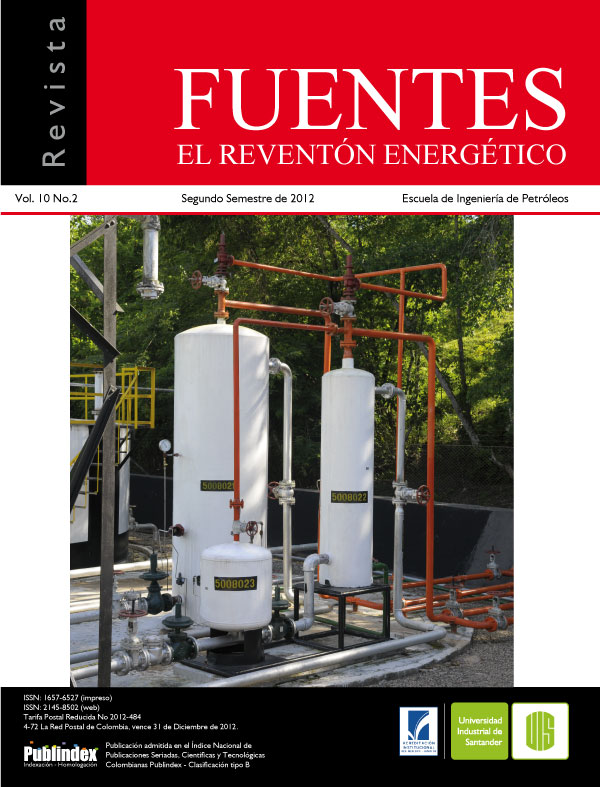Published 2012-11-28
Keywords
- Heavy Oil,
- In-situ Combustion,
- Chemical Reaction,
- Reservoirs,
- Reactor
- Design Equation ...More
How to Cite
Abstract
This work in here presented is the first step in the seeking of the knowledge about in-situ combustion technique for its reliable industrial use.
In the heavy oil recovery there is a technique that currently has a small commercial application because there is ignorance in the chemical phenomena that occurs in the reservoir. Then, to work in these aspects is a necessity to find a solution for the oil exploitable reserves decreasing problem around the world. The chemical study that the technique needs is the big stopping to technique’s high scale application because some important concepts like the kinetic or the oil behaviors in the technique development, are actually ignored and it has a huge impact in the reliable of the project and in the inversion’s safety.
This paper presents the selection among a large number of reactors one with the best operational and physical characteristics to represent an in-situ combustion model and the development of its mathematical mode in order to establish appropriate work conditions in the reactor. This is the plug fow reactor, PFR.
With a work in a laboratory scale and whit the attention put it on the chemistry of the technique, is possible to find the influence of the mass and energy transport phenomena and to know which is the kinetic reaction behavior. If all these concepts are apelied, it can be more easy the understanding and the scaling of the process is defined the technique understanding and the scale up process.
In this work a set of mathematic equations that determines the best conditions to the reactor’s operation, using design equation, mass balance, energy balance and mathematics relations used in the petroleum industry like Darcy’s Law. This set of mathematic equation is a function of the basic first order reaction so it can’t describe the real behavior of the system, but it is an approximation to the real representation.
Downloads
References
2. AZERBAIDZHANSKOE, N. Heat Tratament of oil and increase recovery of oil. SPE. 22356, USA. 1975. 17p
3. AZNAR, A. CABANELAS, J. Ingeniería de Reacciones. Universidad Carlos III de Madrid. Disponible en: http://ocw.uc3m.es/ingenieria-quimica/quimica-ii/material-de-clase-1/MC-F-003.pdf [Citado Mayo de 2012]
4. BELGRAVE, J. MOORE, G. URSENBACH, M. BENNION, W. A Comprehensive approach in situ
5. Benham, A. Poettmann, F. The Thermal Recovery Process - An analysis of Laboratory Combustion Data. Petroleum Trans. AIME.1958.
6. BOUDART, M. Cinética de Procesos Químicos. Alhambra. 1974.
7. BOBERG C Thomas. “Thermal Methods for oil Recovery”, Exxon Monograph. Pag. 266. 1988
8. BURGER, J. SORIEAU P. Thermal methods of oil recovery. Institut Français du Pétrole Publications. 1985.
9. CHICUTA, A. TREVINSON, O. Experimental Study on In-situ Combustion of Brazilian Heavy Oil. UNICAMP-SPE 122036. 2009.
10. CHOPEY. Nicolas. Handbook of Chemical Engineering Calculations. Third Edition. Edición Web.
11. CRAFT, B. HAWKINS, M. Applied Petroleum Reservoir Engineering. Prentice Hall. 1990.
12. CROOKSTON, R. CULHAM, O. Numerical Simulation Model for Thermal Recovery Processes. SPE 6724. Canada. 1985. 18p
13. CUEVAS, R. Introducción a los Reactores Químicos. Universidad Autónoma de México. 2009. Available: http://depa.pquim.unam.mx/amyd/archivero/IntroReactores_10564.pdf [Citado Mayo de 2012].
14. DENBIGH, K. Teoría del Reactor Químico. Alhambra. 1968.
15. Donnelly and R Gordon Moore. “Thermal Cracking models for Athabasca oil Sands”. University of Calgary. SPE 7549
16. ESCOBAR, F. Fundamentos de Inegniería de Yacimientos. Universidad Surcolombiana. 2000.
17. FOGLER, S. Elements of Chemical Reaction Engineering. 2 Ed. Prentice Hall. 1986.
18. GREN, D. WILLHITE, P. Enhaced Oil Recovery. Richarson, SPE. 2003.
19. LAKE, L. Enhaced Oil Recovery. Prentice-Hall. 1989.
20. LEVENSPIEL. Octave. Ingeniería de las Reacciones Químicas. Ed. Reverté.
21. LEVINE, I. Fisicoquímica. McGraw-Hill, Tercera Edición. 1993.
22. MOORE, R. LAURENSHEN, C. UNSERBACH, M. METHA, S. BELGRAVE, J. A Canadien Perspective on In-Situ Combustion. University of Calgary. 1999.
23. MUÑOZ N, Samuel, “Apuntes combustion in-situ”. Universidad Industrial de Santander. Bucaramanga. 1999.
24. N. Kalogerakis, R. Luus. Improvement of Gauss-Newton Method for Parameter Estimation through the Use of Information Index. University of Toronto.1983.
25. NELSON, T. W.; MCNEIL, J.S. “How to Engineer a Combustion In Situ Project”, Oil and Gas Journal. (Junio 5, 1961) N°. 23, 58-65.
26. P,B Crawford and C, Chu. Capitulo VI In situ combustion, “Improve oil Recovery”, Pag 251. Interstate oil Compact comission.1983
27. PARIS DE FERRER, Magdalena. Inyección de Agua y Gas en Yacimientos Petrolíferos.
28. PEROZO, H. MENDOZA, A. TEXEIRA, J. ALVAREZ, A. MÁRQUEZ, J. ORTEGA, P. VASQUEZ, P. The In-situ Combustion Pilot Project in Bare Field, Orinoco Oil Belt, Venezuela. PDVSA INTEVEP, SPE 144484. 2011.
29. PETIT, H. Experimental Evaluation of In-situ Combustion in naturally consolidated cores. Institut Français du Pétrole Publications. JCPT. 1990.
30. Presentation for CMG-Computer Modeling Group Ltda.: GUTIÉRREZ. Dubert. Air Injection-Basic Reaction Kinetics.
31. RAMBOUZE, P. VAN LANDEGHEN, H. WAOQUIER, J. Chemical Reactors; Design/Engineer/Operation. TECHINIP Editions. 1988.
32. RAMEY, H. In-situ Combustion. Published in “Recovery of Hydrocarbons beyond the primary stage” tras World Petroleum Congress Moscow
